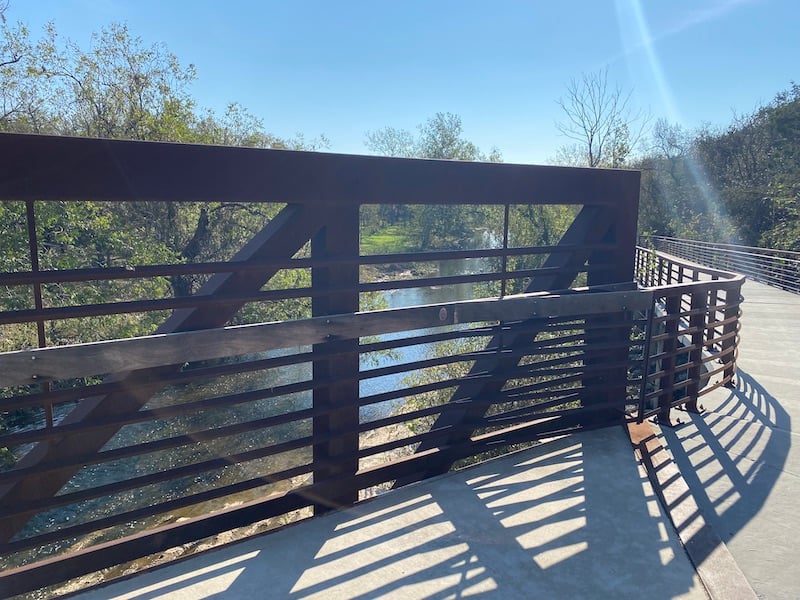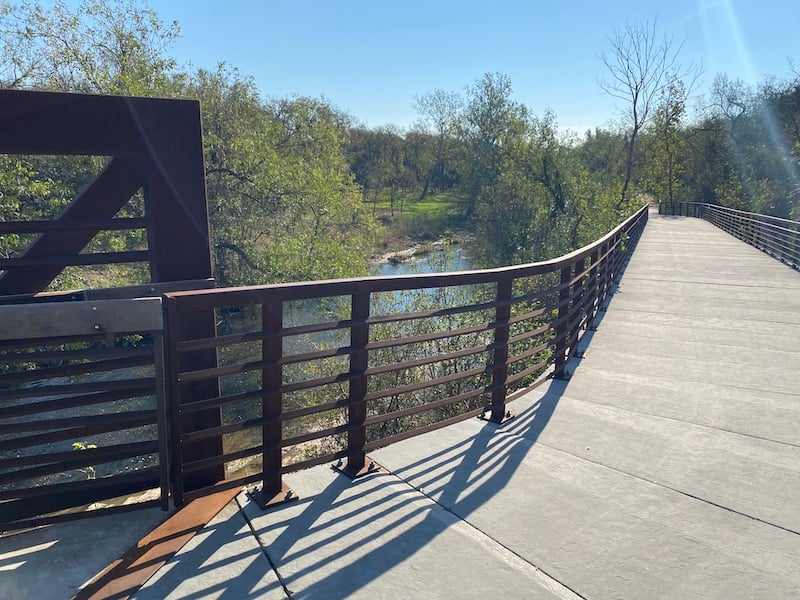Truss Bridge vs. Boardwalk System for Your Pedestrian Bridge Project
When designing a pedestrian bridge that crosses a wetland, creek, or stream, designers are faced with a choice—should you specify a truss bridge or a boardwalk system? Taking it one step further, what if the section of the trail you’re designing for is located in a remote area? We've heard this question from designers recently.
First, it’s important to keep in mind that there are applications best suited for truss bridges, and there are applications best suited for boardwalk systems. Especially when it comes to pedestrian bridge design, there is no shortage of options for the engineer or landscape architect of record.
Consider these 9 factors comparing truss bridges and boardwalk systems to help you find the best solution for your project.
9 Pedestrian Bridge Design Factors to Consider:
1. Pedestrian Bridge Size
The easiest factor to determine the type of structure you will need for your pedestrian bridge design is size.
Truss bridge size
Truss bridges are more economically appropriate for larger spans (50 feet or more) and can accommodate clear spans (the distance between foundations) up to 150 feet for vehicular or 250 feet for pedestrian use. These lengths may be required for pedestrian bridges over roadways or larger bodies of water. The width of the pedestrian bridge may be limited at such extended lengths, but truss bridges enable designers to accomplish these otherwise impossible applications.
Boardwalk system size
Boardwalk systems can be designed for a wider variance in width, but are limited in length between foundations. For example, the PermaTrak system can be designed for widths up to 15 feet 4 inches, but the maximum clear span is 60 feet. Pedestrian bridges that require clear spans longer than 60 feet will be most cost-effectively specified as truss bridges.
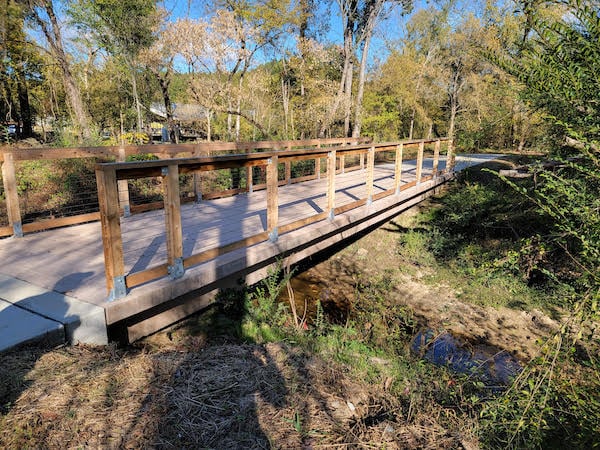 PermaTrak boardwalk in Raleigh with a 40ft clear span.
PermaTrak boardwalk in Raleigh with a 40ft clear span.
2. Familiarity with the pedestrian bridge product
Truss bridge product familiarity
Pedestrian truss bridges are a very common tool in the toolbox for engineers to pull from. Generally speaking, engineers know their preferred vendors that offer pedestrian truss bridge systems. Engineers we work with typically have experience in specifying different types of truss bridges for specific applications. With such a wide range of spans that can be accomplished with a truss bridge, they offer quite a bit of flexibility in design for a multi-use trail.
Boardwalk system boardwalk familiarity
While PermaTrak has designed and produced over 500+ structures in the U.S. and Canada, the idea of a commercial boardwalk system made of precast concrete components is still a new concept for many engineers and landscape architects. Many boardwalk products, such as wood and composite decking, are used primarily for residential applications – and warrant heavy maintenance if used in a commercial trail or pedestrian bridge application.
3. Changes in bridge horizontal or vertical alignment
Truss bridge changes in alignment
On the downside of designing with truss bridge systems, the pedestrian bridge crossings must be straight and cannot be installed in a horizontal curvilinear fashion.
Boardwalk system changes in alignment
Boardwalk systems, however, can accommodate curves, hills, and valleys, allowing for more creativity in a pedestrian bridge design. Many designers want to integrate a trail’s path into the existing landscape, and boardwalk systems can provide a solution for this type of design.
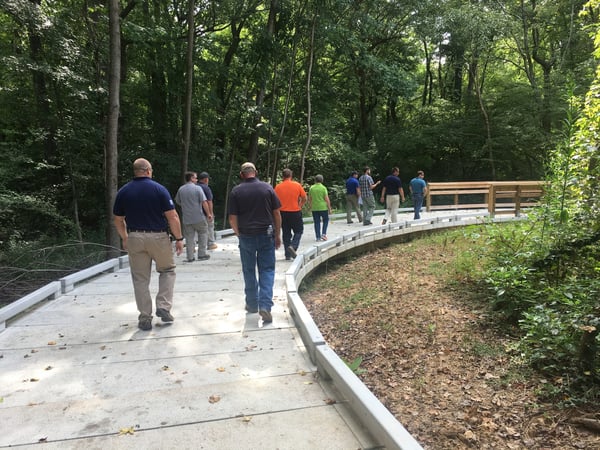
Curved alignment with a concrete boardwalk system.
4. Bridge structural loading requirements
Both truss bridges and commercial boardwalks like PermaTrak can be designed for heavier commercial loads, such as H-5 or H-10 trucks, ambulances, emergency vehicles, and even HS20 vehicular loading and more. They can also both be designed for high traffic areas, such as pedestrian bridge structures that accommodate thousands of daily users.
5. Pedestrian bridge materials
Landscape architects and designers start with an overall vision for their trail projects, and the materials that are used for pedestrian bridges can make a big difference in the overall look and feel of the trail.
Truss bridge materials
When designing a truss bridge for a multi-use trail, there can be several different materials between the trail, bridge foundation, and the bridge itself. For example, an asphalt trail could meet a concrete bridge foundation that leads to a truss bridge with a wooden surface. The number of transitions involved in such a setup can lead to gaps or cracks that require more maintenance, not to mention safety concerns for walkers, runners, and bikers.
Truss bridges can be manufactured from different materials ranging in structural capacity, maintenance needs, and installation requirements. Wood, galvanized steel, painted steel, fiber-reinforced polymer (FRP) composite, and aluminum are all popular construction materials for pedestrian truss bridges.
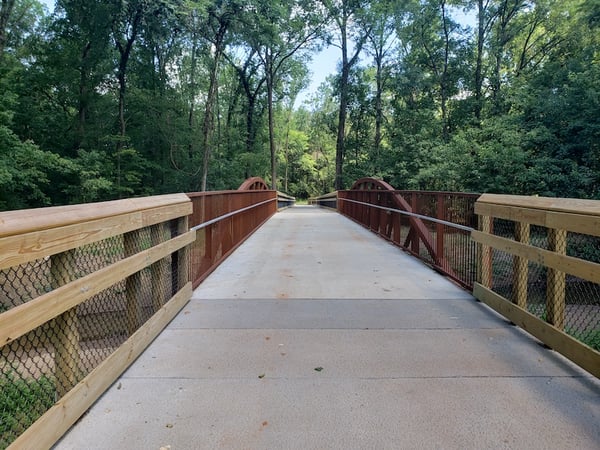 PermaTrak boardwalk meets up to a truss bridge with a 75' span at South Charlotte Connector in Charlotte, NC.
PermaTrak boardwalk meets up to a truss bridge with a 75' span at South Charlotte Connector in Charlotte, NC.
Boardwalk system materials
Boardwalk systems are more versatile and can be integrated seamlessly in a trail design. Because a boardwalk system’s foundations are designed simultaneously with the bridge itself, there are fewer seams, and they can be designed with no seams at all. PermaTrak systems also offer different textures for the walking surface to complete the look of your pedestrian bridge design, while keeping users safe.
With either a truss bridge or boardwalk solution, designers must be cognizant of the surface’s slip resistance – both on Day 1 and after decades of public use. Certain materials, including many plastic composite materials, can become slick under cold or wet conditions, adding to the hazard risk.
6. Required pedestrian bridge maintenance
Truss bridge maintenance
Many truss bridges are constructed with galvanized steel or painted steel, which can corrode and deteriorate over time. Other truss pedestrian bridges may have lower maintenance requirements, such as aluminum or fiber-reinforced polymer composite systems. Truss bridge inspections must happen regularly, while maintenance requirements will vary depending on the project site and quality of the material. Some agencies refer to this as selective maintenance planning, which is often part of a long-term truss bridge solution.
Boardwalk system maintenance
As we’ve shared previously, commercial boardwalk systems will also vary in degree of required maintenance. Is the boardwalk material pressure-treated wood, some type of composite, or precast concrete? A boardwalk system from PermaTrak is maintenance-free with a design life of 50-75 years, saving money and time. Read more below:
Related articles:
Maintenance Costs: Pressure Treated Pine vs. Composite Decking vs. Hardwood vs. Precast Concrete
Life Cycle Maintenance Costs: PermaTrak vs. Wood/Composite Decking
7. Pedestrian bridge cost
Of course, initial costs must be taken into consideration when selecting truss bridge vs. boardwalk for your pedestrian bridge design.
Hard costs to construct truss bridges and boardwalk systems can vary widely depending on your needs, but soft costs such as installation time, inspections, and maintenance can add up quickly. Be sure to consider all the costs involved when you are designing your project.
Consider that truss bridges will clear span 40 ft up to say 250 ft. This mean that the large span must transfer all the structure load to two foundation supports, one per end. The large span simply means larger load and therefore larger and more robust supports. Most commonly truss bridge supports are cast-in-place concrete vertical abutments stemming from a horizontal concrete footing founded on driven piles. It is not uncommon to see heavy driven steel H piles under the concrete abutment. Heavy driven piles means large pile driving equipment and almost certainly eliminates the “top down construction” option. Casting concrete in a stream environment may also require coffer dams be in place for proper concrete placement.
Conversely, a boardwalk system comprise of smaller, modular components that can transfer much smaller loads requiring either lighter piles or smaller spread footings. See the difference in the boardwalk drawings below.
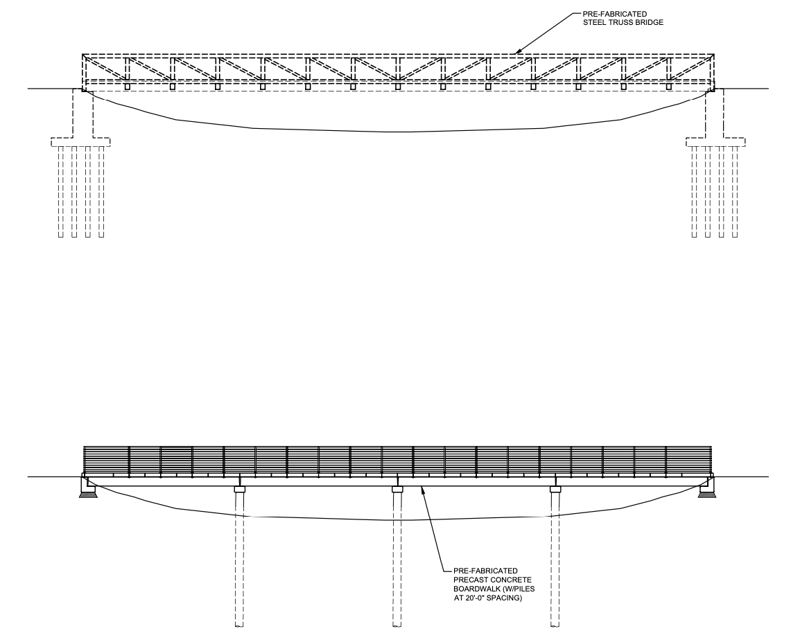
Get a rough boardwalk cost estimate per linear foot by reading our article "Boardwalk Construction Estimates: How Much Does a Boardwalk Cost?"
8. Pedestrian bridge installation and site accessibility
Truss bridges and boardwalk systems differ greatly in how they are installed, and these differences must be taken into consideration during the design phase.
Truss bridge installation
Truss bridges often are built into one large piece that is installed using separately constructed abutment foundations. Installation can be fast; however, in remote locations, it can be extremely difficult to transport the bridge to the site or to move a large crane to the bridge site to install and transport the bridge. Certain types of truss bridges can be transported to remote project sites in pieces and assembled in the field before being set into place.
Boardwalk system installation
On the other hand, boardwalk systems are built and installed using precast abutments that are part of the design. While installation may take longer, it may be easier to transport pieces to the pedestrian bridge site, particularly in remote areas. On environmentally sensitive project sites such as wetlands, PermaTrak's small modular pieces also allow for top-down construction to be possible, an installation method that cannot be accomplished easily with a truss bridge. PermaTrak's system can be installed top-down from the boardwalk itself or as a combination of machines on the ground and on-top of the boardwalk.
The articles below have more information on boardwalk construction:
Related articles:
Boardwalk Construction: PermaTrak Boardwalk System
General Contractors and PermaTrak Concrete Boardwalk Construction - Questions
9. Pedestrian bridge aesthetics
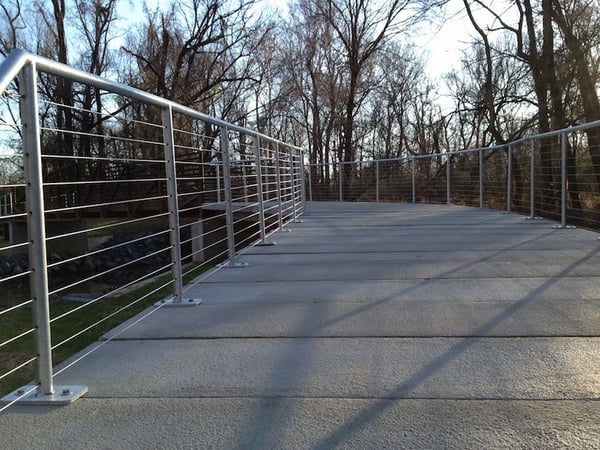 PermaTrak boardwalk with a natural concrete color and sandblast texture.
PermaTrak boardwalk with a natural concrete color and sandblast texture.
Aesthetics is always a matter of preference by the architect/owner.
While some architects actually prefer the ‘look’ of the railing on a truss bridge; the PermaTrak pedestrian bridge allows the pedestrian bridge span to keep the same aesthetic for color, texture and railing throughout the entirety of the boardwalk when large span meets boardwalk on one or both ends.
The railing for a truss bridge is actually a structural component of the bridge (which is one of the reasons they can span so far efficiently). The downside of that is that there are a lot more limitations on the railing style while crossing the truss bridge.
Another factor to consider - the truss bridge impedes the view for the pedestrian, while the boardwalk allows for complete visibility. In situations where the pedestrian bridge is traveling through an attractive wetland or natural area, this can be something for designers to weigh for the overall user experience.
|
The truss bridge impedes visibility. |
The boardwalk allows for greater visibility overall. |
Summary
Are you specifying a pedestrian bridge for your multi-use trail? Set up a time to consult with a member of our engineering team here, or download the PermaTrak Boardwalk Installation Guide for more helpful information.
Whether you are looking to complete a link in a multi-use trail system, extend an elevated greenway, or create a stream crossing, hopefully these points help inform your decision on truss bridge vs. boardwalk for your next pedestrian bridge design.
Check out PermaTrak’s Project Profiles to see how our maintenance-free boardwalk systems are being used as pedestrian bridges on multi-use trails.
Photo credit: First photo by Brent Moore.



